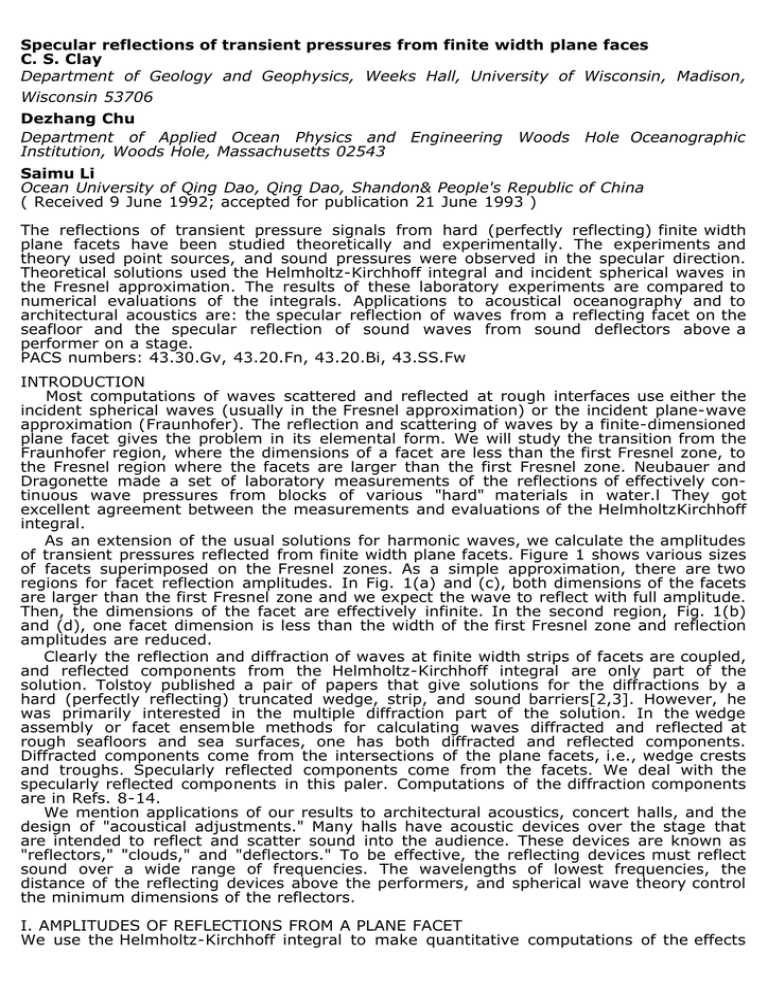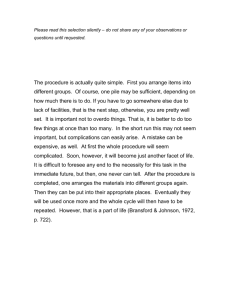sole paper to be open from here
advertisement

Specular reflections of transient pressures from finite width plane faces C. S. Clay Department of Geology and Geophysics, Weeks Hall, University of Wisconsin, Madison, Wisconsin 53706 Dezhang Chu Department of Applied Ocean Physics and Engineering Woods Hole Oceanographic Institution, Woods Hole, Massachusetts 02543 Saimu Li Ocean University of Qing Dao, Qing Dao, Shandon& People's Republic of China ( Received 9 June 1992; accepted for publication 21 June 1993 ) The reflections of transient pressure signals from hard (perfectly reflecting) finite width plane facets have been studied theoretically and experimentally. The experiments and theory used point sources, and sound pressures were observed in the specular direction. Theoretical solutions used the Helmholtz-Kirchhoff integral and incident spherical waves in the Fresnel approximation. The results of these laboratory experiments are compared to numerical evaluations of the integrals. Applications to acoustical oceanography and to architectural acoustics are: the specular reflection of waves from a reflecting facet on the seafloor and the specular reflection of sound waves from sound deflectors above a performer on a stage. PACS numbers: 43.30.Gv, 43.20.Fn, 43.20.Bi, 43.SS.Fw INTRODUCTION Most computations of waves scattered and reflected at rough interfaces use either the incident spherical waves (usually in the Fresnel approximation) or the incident plane-wave approximation (Fraunhofer). The reflection and scattering of waves by a finite-dimensioned plane facet gives the problem in its elemental form. We will study the transition from the Fraunhofer region, where the dimensions of a facet are less than the first Fresnel zone, to the Fresnel region where the facets are larger than the first Fresnel zone. Neubauer and Dragonette made a set of laboratory measurements of the reflections of effectively con­ tinuous wave pressures from blocks of various "hard" materials in water.l They got excellent agreement between the measurements and evaluations of the HelmholtzKirchhoff integral. As an extension of the usual solutions for harmonic waves, we calculate the amplitudes of transient pressures reflected from finite width plane facets. Figure 1 shows various sizes of facets superimposed on the Fresnel zones. As a simple approximation, there are two regions for facet reflection amplitudes. In Fig. 1(a) and (c), both dimensions of the facets are larger than the first Fresnel zone and we expect the wave to reflect with full amplitude. Then, the dimensions of the facet are effectively infinite. In the second region, Fig. 1(b) and (d), one facet dimension is less than the width of the first Fresnel zone and reflection amplitudes are reduced. Clearly the reflection and diffraction of waves at finite width strips of facets are coupled, and reflected components from the Helmholtz-Kirchhoff integral are only part of the solution. Tolstoy published a pair of papers that give solutions for the diffractions by a hard (perfectly reflecting) truncated wedge, strip, and sound barriers[2,3]. However, he was primarily interested in the multiple diffraction part of the solution. In the wedge assembly or facet ensemble methods for calculating waves diffracted and reflected at rough seafloors and sea surfaces, one has both diffracted and reflected components. Diffracted components come from the intersections of the plane facets, i.e., wedge crests and troughs. Specularly reflected components come from the facets. We deal with the specularly reflected components in this paler. Computations of the diffraction components are in Refs. 8-14. We mention applications of our results to architectural acoustics, concert halls, and the design of "acoustical adjustments." Many halls have acoustic devices over the stage that are intended to reflect and scatter sound into the audience. These devices are known as "reflectors," "clouds," and "deflectors." To be effective, the reflecting devices must reflect sound over a wide range of frequencies. The wavelengths of lowest frequencies, the distance of the reflecting devices above the performers, and spherical wave theory control the minimum dimensions of the reflectors. I. AMPLITUDES OF REFLECTIONS FROM A PLANE FACET We use the Helmholtz-Kirchhoff integral to make quantitative computations of the effects of facet widths on reflection amplitudes. Since the Helmholtz-Kirchhoff integral is for continuous waves, we suppress the time dependence and calculate the pressure P(f) as a function of frequency f. Expressions for the Helmholtz-Kirchhoff integral are in Neubauer and Dragonette,1 Clay and Medwin (1977),15 and Clay (1990).14 Expressions from Clay and Medwin are designated as GM. After making the Kirchhoff approximation, the Helmholtz-Kirchhofl' integral is (C-M A10.5.7) Fig.4 Fig.5 FIG.4.[ on left] Relative reflection amplitudes of transient signals ?g(u,8)? FIG. 5 [on right]. Laboratory experimental geometry and a pressure signal. (a) The experiments were made in air. The spark source and pressure receiver are nearly colocated. The facet is made of plaster wall board and the Boor is cement. The facet length 120 cm is effectively infinite. (b) Typical pressure signal. The direct arrival was suppressed. The reflection from the facet is called "facet" and the reflection from the Boor is labeled "floor." Diffraction arrivals are relatively small for this geometry. III. EXPERIMENTS AND THEORY Figure 5 shows a laboratory experiment and a typical signal.lg Relative to air, plaster wall board is very hard and dense and the reflection coefficient is nearly unity. These plaster materials damp vibrations and are good for laboratory acoustic experiments. The data were taken near vertical incidence and ?=0. The part of the signal labeled "Facet" was isolated from the rest of the signal to study the reflection from the 4-cm-width facet. The reference pressure or p8( t) was achieved by replacing the small facet by a large sheet of plaster sheet board at the same range. An example of an unfiltered p8(t) is shown in Fig. 6(a). We delayed digitization and recording of the signal until just before the signal arrived. The corresponding spectrum is labeled "source-system response" in Fig. 6(c). We digitally recorded p8(t) and then used FFT-filter-IFFT operations to calculate pressures for a set of signals having peak frequencies that range from 3 to 20 kHz. An example of filtered p8(t) for a peak frequency of 3 kHz is shown in Fig. 6(b) and its spectrum is shown in Fig. 6(c). The filtered domain signals were time shifted for display. The filtered p8(t) resembles a damped sine wave. Reflected sound pressures from the facets were processed the same way and filtered signals were computed for the pair, p(t) and p8(t). The wavelengths ?p that correspond to spectral peaks were computed for each pair of filtered signals. The ?p range, and facet widths were used to compute a and the experimental values of g exp( u, 8) shown in Fig. 7. Theoretical calculations of g(u, 8), also shown in Fig. 7, used the damped sine wave signal ( 33 ) where the damping constant was T=1/fP. (38) The theoretical curve of g(u, oo ) was computed as a function of u, i.e., fP using (32) and (36). The experimental values of g exp( u, 8) are a little larger than the theoretical curve between u=1 and 1.5. IV. SOUND DEFLECTORS IN MUSIC HALLS Sound deflectors are often placed over the stage in concert halls. As sketched in Fig. 8, the deflector reflects some of the upward traveling sound waves from a performer on the stage into the seating area. The stage overhead and ceiling are not shown. Since deflectors are part of the stage, the designs can be rather decorative. Depending on the acoustical problems with the room, the sound deflectors may also be intended to reinforce specific frequency ranges. Sometimes designers use a "rule of thumb" that the deflectors scatter and reflect all waves that have ? less than the dimensions of the deflector. We believe that the finite facet theory gives an improved "rule of thumb." The pressure facet reflection factor ( 21) gives the pressure reflected by a facet relative to the pressure reflected by an... ACKNOWLEDGMENTS This paper is taken from a tutorial that was written after Clay's conversations with John Preston and others at the ASW Research Center, La Spezia, Italy. Herman Medwin gave our paper a delightfully critical review. Our research was supported by many individuals and sources. Support came from the following: the Center for Polar Research and the Department of Geology and Geophysics of the University of Wisconsin; the Office of Naval Research, Mr. Robert Obrochta (N00014-84-K-0611) and Dr. Joseph Kravitz (N00014-86-K-0323); Naval Research Laboratory-Stennis Space Center, Mr. Richard Keiffer (N00014-88-K-6007) and Mr. Roger Meredith (N0001491-J-6004); and the Ocean University of Quing Dao. 1. W. G. Neubauer and L. R. Dragonette, "Monostatic reflection from a rigid rectangular plate," J. Acoust. Soc. Am. 41, 656-661 (1967). 2. I. Tolstoy, "Diffraction by a hard truncated wedge ans a strip," IEEE J. Ocean Eng. 14, 4-16 (1989). 3. I. Tolstoy, "Exact, explicit solutions for diffraction by hard sound barriers and seamounts," J. Acoust. Soc. Am. 85, 661-669 (1989). 4. W. A. Kinney, C. S. Clay, and G. A. Sandness, "Scattering from a corrugated surface: Helmholtz-Kirchhoff theory and the facet­ ensemble method," J. Acoust. Soc. Am. 73, 183-194 (1983). 5. J. C. Novarini and H. Medwin, "Computer modeling resonant sound scattered from a periodic assemblage of wedges: Comparisons with theories of diffraction gratings;' J. Acoust. Soc. Am. 73, 183-194 (1983). 6. H. Medwin, "Shadowing by finite noise barriers," J. Acoust. Soc. Am. 72, 1005-1013 (1982). 7. H. Medwin, E. Childs, and G. M. Jebsen, "Impulse studies in double diffraction: A discrete Huygens interpretation," 1. Acoust. Soc. Am. 73, 183-194 (1983). 8. M. A. Biot and I. Tolstoy, "Formulation of wave propagation in infinite media by normal coordinates with an application to diffraction," J. Acoust. Soc. Am. 29, 381-391 (1957). 9. Tolstoy and C. S. Clay, Ocean Acoustics.' Theory and Experiment in Underwater Sound 2nd Edition (American Institute of Physics, Now York, 1987), Appendix 5 is Ref. 8. 10. S. Li and C. S. Clay, "Sound transmission experiments from an impulsive source near rigid wedges," J. Acoust. Sac. Am. 84, 2135-2143 (1988). 11. D. Chu, "Impulse response of a density contrast wedge using normal coordinates," Ph.D. thesis, University of Wisconsin-Madison (1989). Extends the exact Riot Tolstoy solutiona~9 to fluid wedges having finite density contrasts. Again the exact solution is the sum of a diffraction term and "image" reflections. 12. D. Chu, "Impulse response of density contrast wedge using normal coordinates," J. Acoust. Soc. Am. 86, 1883-1896 (1989). 13. D. Chu, "Enact solution for a density contrast shallow-water wedge using normal coordinates," J. Acoust. Soc. Am. 87, 24422450 (1990). 14. C. S. Clay, Elementary Exploration Seismology (Prentice Hall, Eng1ewood Cliffs, NJ, 1990), Chap. 14 and Appendix C1.2. 15. C.S. Clay and Herman Medwin, Acoustical Oceanography (Wiley, New York, 1977), Sees. 10.4 and 10.5 and Appendix AI0.5. 16. M. Abramowitz and I. A. Stegun (Eds.), Nand6ook of Mathematical Functions, Appl. Math. Ser. 55 (National Bureau of Standards, U.S. Government Printing Office, Washington, DC, 1965). 17. C. S. Clay and W. A. Kinney, "Numerical computations of time domain diffractions from wedges and reflections from facets," J. Acoust. Soc. Am. 83, 2126-2133 (1988). 18. S. Li and C. S. Clay, "Experimentation of time domain di9'raedons from wedges and reflections from facets" (in Chinese), Acta Acustica 17, 56-64 (1992 ). Contains comparisons of the reflections of transient pressures from finite dimensioned facets and the theory in Ref. I7. The agreement is good. 19. A. W. Trorey, "A simple theory for seismic diffractions," Geophysics 35 762-784 (1970). Gives an impulsive evalution of the Helmholtz - The Kirchhoff integral, also known as the Rabinowitz solution [M. Born agreement is good. and E. Wolf, Principles of Optics (Pergamon, Oxford, 1965), Sec. 8.9]. 20. M. Jebsen and H. Medwin, "On the failure of the Kirchhoff assumptions in backscatter," J. Acoust. Soc. Am. 72, 1607-1611 (1982). From : The Journal of the Acoustical Society of America 94(1993)October, No.4, Woodbury,
